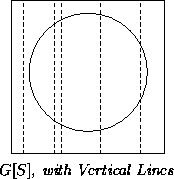




Next: 4.5 Optimization: Removing Conditionals
Up: 4 Graphs
Previous: 4.3.5 Examples of Cutting Heuristics
The specification S can be broken into
several pieces, based upon its dependence on
x and y:
For example,
may be transformed into
with
This is a natural extension of common sub-expression
elimination, present in optimizing compilers [3].
Applying common sub-expression elimination
in conjunction with symbolic rewriting,
the example is transformed into
with
Such transformations are useful when evaluating S
many times, which occurs during rendering.
Let  ;
after evaluating
;
after evaluating
the evaluation of
is more efficient if
some sub-expressions need not be re-evaluated.
With aligned cuts, it is likely that
has sub-expressions that have been evaluated before.
For example, with cuts aligned along a  grid,
are each computed 32 times, instead of 1024 times,
if sub-expressions are cached; these calculations assume that
every grid cell contains one pixel cluster.
Caching
grid,
are each computed 32 times, instead of 1024 times,
if sub-expressions are cached; these calculations assume that
every grid cell contains one pixel cluster.
Caching  takes minimal memory, and aids computation
considerably; with our previous example, it would be computed
once, instead of 1024 times, if
takes minimal memory, and aids computation
considerably; with our previous example, it would be computed
once, instead of 1024 times, if  is cached.
is cached.
A better estimate of cache utility may be made by
considering the graph being rendered. For  ,
consider vertical lines, as shown in the following figure:
,
consider vertical lines, as shown in the following figure:
In the example shown, most lines intersect G twice;
it follows that  is usually computed
twice, for each possible value of
is usually computed
twice, for each possible value of  .
Interval evaluation may ``smear'' the graph, so that
.
Interval evaluation may ``smear'' the graph, so that
 may be computed several times
for each actual intersection.
may be computed several times
for each actual intersection.





Next: 4.5 Optimization: Removing Conditionals
Up: 4 Graphs
Previous: 4.3.5 Examples of Cutting Heuristics
![]()
![]()
![]()
![]()
![]()
![]()
![]()
![]()
![]()
![]()
![]()
![]() ;
after evaluating
;
after evaluating
![]()
![]()
![]()
![]()
![]()
![]() ,
consider vertical lines, as shown in the following figure:
,
consider vertical lines, as shown in the following figure:
